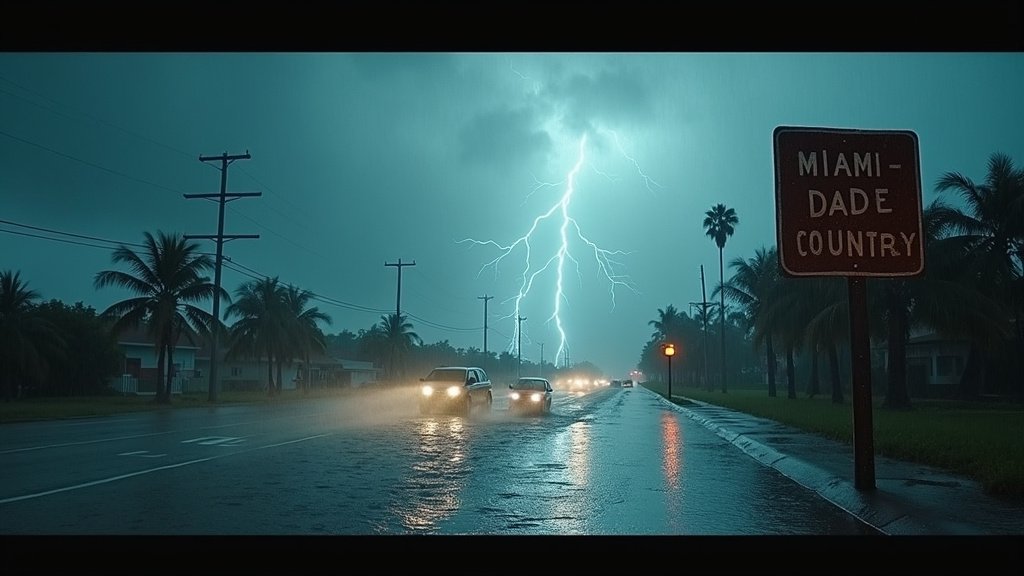Miami-Dade Issues Revised Hurricane Preparedness Guide as 2025 Season Commences
Miami-Dade County emergency management officials today released updated guidelines designed to enhance community resilience and safety as the 2025 Atlantic Hurricane Season officially gets underway, having begun on June 1st. The revised guidance arrives at a critical juncture, emphasizing the ongoing and dynamic nature of storm threats and the need for residents to proactively assess their readiness. This comprehensive update is intended to provide residents, businesses, and visitors with the most current information and tools necessary to prepare effectively for potential tropical cyclone impacts throughout the season, which runs until November 30th. The proactive steps outlined in these guidelines are crucial for minimizing risk and ensuring a coordinated community response should a storm threaten the region.
Crucial Updates to Evacuation Zones Based on Latest Science
A significant component of the updated guidance involves crucial adjustments to coastal evacuation zones across Miami-Dade County. These revisions are not arbitrary but are based on the latest storm surge risk assessments conducted by meteorological and hydrological experts. Storm surge, often the most dangerous and deadly aspect of a hurricane, is the abnormal rise of water generated by a storm’s winds pushing water onshore. Factors like storm intensity, size, forward speed, angle of approach to the coast, and local topography all influence the potential for surge. The updated zones reflect refined modeling and data that better predict which areas are most vulnerable to inundation under various storm scenarios. These changes mean that properties previously designated in one zone may now be in a different zone, or areas not previously in an evacuation zone might now be included. Understanding these updated zones is paramount for residents, as zone designations determine mandatory evacuation orders issued by county authorities during an impending storm threat. Evacuation is a measure of last resort, ordered when staying in a specific location is deemed unsafe due to the risk of storm surge or extreme winds, or potentially due to wind impacts in some designated zones.
Residents Urged to Verify Their Specific Evacuation Zone Immediately
Given the changes, authorities are strongly encouraging all Miami-Dade County residents to visit the county’s official website or use the AlertMiami system immediately to verify their current zone designation. The county’s online platforms and the AlertMiami service provide user-friendly tools where residents can input their specific address and instantly receive their updated evacuation zone information. Verifying this information now, before a storm is even on the horizon, is critical. Waiting until a storm approaches could lead to confusion, delays, and potentially dangerous situations during an emergency response. Officials stress that knowing your zone is the first step in determining whether you might be required to evacuate and understanding the level of surge risk associated with your property. The AlertMiami system also serves as a vital communication channel, providing timely alerts and information directly from county officials during emergencies, including evacuation orders, shelter openings, and post-storm recovery information. Residents who have not already signed up for AlertMiami are strongly advised to do so without delay to ensure they receive these crucial notifications directly to their phones or email.
Emphasis on Comprehensive Disaster Planning: Beyond Evacuation Zones
While understanding evacuation zones is vital, Miami-Dade County officials also heavily emphasized the broader importance of having a comprehensive disaster plan. An effective hurricane preparedness plan extends far beyond knowing if you are in an evacuation zone. It is a multi-faceted approach designed to ensure the safety and well-being of individuals, families, and even pets, before, during, and after a storm. Key components highlighted by authorities include stocking at least seven days of supplies and identifying potential shelter locations well in advance of any storm activity. The recommendation for seven days of supplies reflects the potential for extended power outages, impassable roads, and disruptions to normal services like grocery stores or pharmacies following a significant hurricane. A well-stocked disaster kit should include essential items such as water (one gallon per person per day), non-perishable food, medications (at least a seven-day supply for all family members, including prescriptions), a first-aid kit, flashlights, extra batteries, a multi-tool or manual can opener, sanitation and personal hygiene items, cash (ATMs may not work), important documents (insurance papers, identification, medical records) secured electronically or in a waterproof bag, blankets or sleeping bags, and adequate pet supplies (food, water, leash, carrier, identification). Charging electronic devices beforehand and having alternative charging methods like power banks, car chargers, or solar chargers are also crucial in today’s connected world for communication.
Identifying potential shelter locations is another critical step in the planning process. This doesn’t solely mean public shelters managed by the county, although those are an option for residents whose homes are unsafe or who are ordered to evacuate. Identifying shelter can also mean planning to stay with friends or family who live outside of potentially impacted zones (e.g., further inland or in another county), or having a plan to travel to a hotel inland if resources allow. For those who may need to rely on public shelters, it is important to understand that these facilities offer basic needs (shelter, food, water) but do not provide comfort items or extensive personal space. Public shelters should be identified in advance, and residents should know what to expect and what to bring (supplies from their disaster kit). Officials underscore that waiting until the last minute to determine your shelter plan can lead to dangerous travel during deteriorating weather conditions and may find shelters already at capacity or closed.
Public Information Sessions Scheduled to Assist Residents
To further assist residents in understanding the newly released guidelines, the updated evacuation zones, and the critical steps involved in comprehensive preparedness, Miami-Dade County has scheduled a series of public information sessions. These sessions are designed to provide a forum for residents to ask questions, receive direct guidance from emergency management personnel, and access resources in person. The sessions are scheduled to take place throughout the week at various locations across the county, including community centers and government buildings. Specific dates, times, and venues for these sessions can be found on the county’s official website and through the AlertMiami system. Residents are strongly encouraged to attend one of these sessions, particularly if they have questions about the new evacuation zones, need assistance verifying their address, or require personalized guidance in developing or refining their family disaster plan. These sessions represent a valuable opportunity to engage directly with the experts, clarify any uncertainties, and ensure you are fully prepared for the season ahead by taking concrete, informed steps.
Proactive Preparation is Key for Miami-Dade
In conclusion, with the 2025 Atlantic Hurricane Season now active since June 1st, Miami-Dade County’s issuance of updated preparedness guidelines and the adjustment of evacuation zones serve as a timely and critical reminder of the importance of proactive action. Officials reiterated that preparedness is a shared responsibility between government and residents. By taking the steps outlined – verifying your evacuation zone immediately, developing a comprehensive disaster plan including stocking supplies for at least seven days, identifying shelter options in advance, and utilizing county resources like the official website, AlertMiami, and public information sessions – residents significantly enhance their safety and resilience. Preparing now, while conditions are calm and resources are readily available, is the most effective way to navigate the uncertainties that the hurricane season may bring and protect lives and property in Miami-Dade County.





